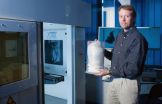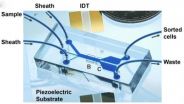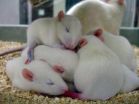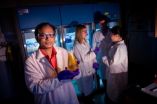SA's Taung Child's skull and brain not human-like in expansion
CT scan disproves support for similar infant brain development to that of modern humans
2014-08-25
(Press-News.org) The Taung Child, South Africa's premier hominin discovered 90 years ago by Wits University Professor Raymond Dart, never seizes to transform and evolve the search for our collective origins.
By subjecting the skull of the first australopith discovered to the latest technologies in the Wits University Microfocus X-ray Computed Tomography (CT) facility, researchers are now casting doubt on theories that Australopithecus africanus shows the same cranial adaptations found in modern human infants and toddlers – in effect disproving current support for the idea that this early hominin shows infant brain development in the prefrontal region similar to that of modern humans.
The results have been published online in the prestigious journal Proceedings of the National Academy of Sciences (PNAS) on Monday, 25 August 2014 at 21:00 SAST (15:00 EST), in an article titled: New high resolution CT data of the Taung partial cranium and endocast and their bearing on metopism and hominin brain evolution.
The Taung Child has historical and scientific importance in the fossil record as the first and best example of early hominin brain evolution, and theories have been put forward that it exhibits key cranial adaptations found in modern human infants and toddlers.
To test the ancientness of this evolutionary adaptation, Dr Kristian J. Carlson, Senior Researcher from the Evolutionary Studies Institute at the University of the Witwatersrand, and colleagues, Professor Ralph L. Holloway from Columbia University and Douglas C. Broadfield from Florida Atlantic University, performed an in silico dissection of the Taung fossil using high-resolution computed tomography.
"A recent study has described the roughly 3 million-year-old fossil, thought to have belonged to a 3 to 4-year-old, as having a persistent metopic suture and open anterior fontanelle, two features that facilitate post-natal brain growth in human infants when their disappearance is delayed," said Carlson.
Comparisons with the existing hominin fossil record and chimpanzee variation do not support this evolutionary scenario.
Citing deficiencies in how the Taung fossil material has been recently assessed, the researchers suggest physical evidence does not incontrovertibly link features of the Taung skull, or its endocast, to early prefrontal lobe expansion, a brain region implicated in many human behaviors.
The authors also debate the previously offered theoretical basis for this adaptation in A. africanus. By refuting the presence of these features in the Taung Child, the researchers dispute whether these structures were selectively advantageous in hominin evolution, particularly in australopiths.
Thus, results of the new study show that there is still no evidence for this kind of skull adaptation that evolved before Homo, nor is there evidence for a link between such skull characteristics and the proposed accompanying early prefrontal lobe expansion, Carlson said.
INFORMATION:
ELSE PRESS RELEASES FROM THIS DATE:
A long childhood feeds the hungry human brain
2014-08-25
EVANSTON, Ill. -- A five-year old's brain is an energy monster. It uses twice as much glucose (the energy that fuels the brain) as that of a full-grown adult, a new study led by Northwestern University anthropologists has found.
The study helps to solve the long-standing mystery of why human children grow so slowly compared with our closest animal relatives.
It shows that energy funneled to the brain dominates the human body's metabolism early in life and is likely the reason why humans grow at a pace more typical of a reptile than a mammal during childhood.
Results ...
Black carbon -- a major climate pollutant -- also linked to cardiovascular health
2014-08-25
Black carbon pollutants from wood smoke are known to trap heat near the earth's surface and warm the climate. A new study led by McGill Professor Jill Baumgartner suggests that black carbon may also increase women's risk of cardiovascular disease.
To investigate the effects of black carbon pollutants on the health of women cooking with traditional wood stoves, Baumgartner, a researcher at McGill's Institute for the Health and Social Policy, measured the daily exposure to different types of air pollutants, including black carbon, in 280 women in China's rural Yunnan province.
Baumgartner ...
Tilted acoustic tweezers separate cells gently
2014-08-25
Precise, gentle and efficient cell separation from a device the size of a cell phone may be possible thanks to tilt-angle standing surface acoustic waves, according to a team of engineers.
"For biological testing we often need to do cell separation before analysis," said Tony Jun Huang, professor of engineering science and mechanics. "But if the separation process affects the integrity of the cells, damages them in any way, the diagnosis often won't work well."
Tilted-angle standing surface acoustic waves can separate cells using very small amounts of energy. Unlike ...
New biomarker highly promising for predicting breast cancer outcomes
2014-08-25
A protein named p66ShcA shows promise as a biomarker to identify breast cancers with poor prognoses, according to research published ahead of print in the journal Molecular and Cellular Biology.
Cancer is deadly in large part due to its ability to metastasize, to travel from one organ or tissue type to another and malignantly sprout anew. The vast majority of cancer deaths are associated with metastasis.
In breast cancer, a process called "epithelial to mesenchymal transition" aids metastasis. Epithelial cells line surfaces which come into contact with the environment, ...
Exposure to toxins makes great granddaughters more susceptible to stress
2014-08-25
Scientists have known that toxic effects of substances known as endocrine disrupting chemicals (EDCs), found in both natural and human-made materials, can pass from one generation to the next, but new research shows that females with ancestral exposure to EDC may show especially adverse reactions to stress.
According to a new study by researchers from The University of Texas at Austin and Washington State University, male and female rats are affected differently by ancestral exposure to a common fungicide, vinclozolin. Female rats whose great grandparents were exposed ...
MU researchers discover protein's ability to inhibit HIV release
2014-08-25
COLUMBIA, Mo. — A family of proteins that promotes virus entry into cells also has the ability to block the release of HIV and other viruses, University of Missouri researchers have found.
"This is a surprising finding that provides new insights into our understanding of not only HIV infection, but also that of Ebola and other viruses," said Shan-Lu Liu, M.D., Ph.D., associate professor in the MU School of Medicine's Department of Molecular Microbiology and Immunology.
The study was recently published in the Proceedings of the National Academy of Sciences. Liu, the ...
Cancer-fighting drugs might also stop malaria early
2014-08-25
DURHAM, N.C. -- Scientists searching for new drugs to fight malaria have identified a number of compounds -- some of which are currently in clinical trials to treat cancer -- that could add to the anti-malarial arsenal.
Duke University assistant professor Emily Derbyshire and colleagues identified more than 30 enzyme-blocking molecules, called protein kinase inhibitors, that curb malaria before symptoms start.
By focusing on treatments that act early, before a person is infected and feels sick, the researchers hope to give malaria –- especially drug-resistant strains ...
Sweet! Glycoconjugates are more than the sum of their sugars
2014-08-25
There's a certain type of biomolecule built like a nano-Christmas tree. Called a glycoconjugate, it's many branches are bedecked with sugary ornaments.
It's those ornaments that get all the glory. That's because, according to conventional wisdom, the glycoconjugate's lowly "tree" basically holds the sugars in place as they do the important work of reacting with other molecules.
Now a chemist at Michigan Technological University has discovered that the tree itself—called the scaffold—is a good deal more than a simple prop.
"We had always thought that all the biological ...
Doctors miss opportunities to offer flu shots
2014-08-25
Doctors should make a point of offering a flu vaccine to their patients. A simple reminder could considerably reduce the number of racial and ethnic minorities who currently do not vaccinate themselves against this common contagious respiratory illness. This recommendation is based on research led by Jürgen Maurer of the University of Lausanne in Switzerland and the RAND Corporation in the US. Their findings¹ are published in the Journal of General Internal Medicine², published by Springer.
Up to 50,000 Americans die annually of influenza and related diseases such as ...
New coping strategy for the memory impaired and their caregivers
2014-08-25
CHICAGO --- Mindfulness training for individuals with early-stage dementia and their caregivers together in the same class was beneficial for both groups, easing depression and improving sleep and quality of life, reports new Northwestern Medicine study.
"The disease is challenging for the affected person, family members and caregivers," said study lead author Ken Paller, professor of psychology at Weinberg College of Arts and Sciences at Northwestern and a fellow of the Cognitive Neurology and Alzheimer's Disease Center at Northwestern University Feinberg School of ...
LAST 30 PRESS RELEASES:
Bluey’s dad offered professorial chair in archaeology at Griffith University
Beyond small data limitations: Transfer learning-enabled framework for predicting mechanical properties of aluminum matrix composites
Unveiling non-thermal catalytic origin of direct current-promoted catalysis for energy-efficient transformation of greenhouse gases to valuable chemicals
Chronic breathlessness emerging as a hidden strain on hospitals
Paleontologists find first fossil bee nests made inside fossil bones
These fossils were the perfect home for ancient baby bees
Not everyone reads the room the same. A new study examines why.
New research identifies linked energy, immune and vascular changes in ME/CFS
Concurrent frailty + depression likely boost dementia risk in older people
Living in substandard housing linked to kids’ missed schooling and poor grades
Little awareness of medical + psychological complexities of steroid cream withdrawal
Eight in 10 trusts caring for emergency department patients in corridors, finds BMJ investigation
NASA’s Webb telescope finds bizarre atmosphere on a lemon-shaped exoplanet
The gut bacteria that put the brakes on weight gain in mice
Exploring how patients feel about AI transcription
Category ‘6’ tropical cyclone hot spots are growing
Video: Drivers struggle to multitask when using dashboard touch screens, study finds
SLU research shows surge in alcohol-related liver disease driving ‘deaths of despair’
Rising heat reshapes how microbes break down microplastics, new review finds
Roots reveal a hidden carbon pathway in maize plants
Membrane magic: FAMU-FSU researchers repurpose fuel cells membranes for new applications
UN Member States pledge to increase access to diagnosis and inhaled medicines for the 480 million people living with COPD
Combination therapy shows potential to treat pediatric brain cancer ATRT
Study links seabird nesting to shark turf wars in Hawai‘i
Legal sports betting linked to sharp increases in violent crime, study finds
Breakthrough AI from NYUAD speeds up discovery of life-supporting microbes
New Eva Mayr-Stihl Foundation funding initiative boosts research at University of Freiburg on adaptation of forests to global change
The perfect plastic? Plant-based, fully saltwater degradable, zero microplastics
Bias in data may be blocking AI’s potential to combat antibiotic resistance
Article-level metrics would provide more recognition to most researchers than journal-level metrics
[Press-News.org] SA's Taung Child's skull and brain not human-like in expansionCT scan disproves support for similar infant brain development to that of modern humans





